Showing all 8 results

Cape Raoul, southern Tasmania
Watercolour and gouache on 640 gsm hot press Lana rag paper - H80 cms x W 100 cms. Unframed
The Short-tailed Shearwater (Ardenna tenuirostris) is Australia’s most numerous seabird. During breeding season, millions converge on many small islands around southern Australia, with their stronghold in Bass Strait. Cape Raoul is at the southernmost tip of the Tasman Peninsula in Tasmania. The cape features rock platforms, towering 300 metre cliffs, columns and off-shore islands.
Please get in contact for more information.
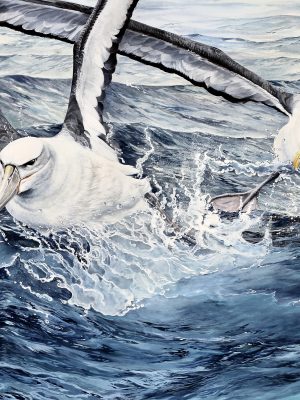
Limited Edition print size: 80 cm x 100 cm.
'The Feeding Frenzy ' - Tasmanian Shy Albatross (Thelassarche cauta)
The IUCN classifies this species as near threatened with less than 25,000 breeding animals. Today, longline fishing still impacts this species but their numbers have been maintained despite this threat. The shy albatross feeds by a combination surface-seizing and some pursuit diving – it has been recorded diving as deep as 5 m
*Price includes postage anywhere within Australia
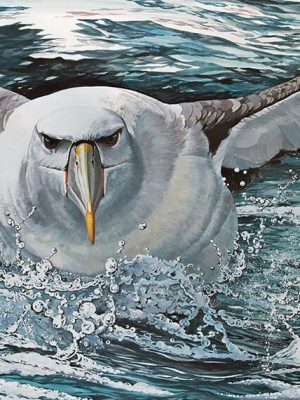
Print Size: 100cm x 60cm
Soaring majestically above the oceans between Australia and Africa, the shy albatross appears not to have a care in the world. Breeding only on Australian islands, it can live for up to 40 years and enjoys the partnership of a life-long mate.
Pairs are faithful –to each other and their breeding sites on just three remote islands off Tasmania. They breed annually and produce a single egg, which is incubated for 72 days. Both parents tend the demanding chick for the first five months of its life and that fledgling will return to the same breeding colony when it matures, but not until at least three years of age.
*Price includes postage anywhere within Australia.

Print Size: 80cm x 60cm
The Australasian gannet (Morus serrator), also known as Australian gannet and tākapu, is a large seabird of the booby and gannet family, Sulidae. Adults are mostly white, with black flight feathers at the wingtips and lining the trailing edge of the wing. The central tail feathers are also black. The head is tinged buff-yellow, with a pale blue-grey bill edged in black, and blue-rimmed eyes. Young birds have mottled plumage in their first year, dark above and light below. The head is an intermediate mottled grey, with a dark bill. The birds gradually acquire more white in subsequent seasons until they reach maturity after five years.
*Price includes postage anywhere within Australia.
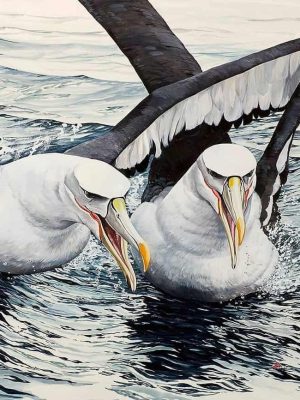
Print Size: 80cm x 60cm
Soaring majestically above the oceans between Australia and Africa, the shy albatross appears not to have a care in the world. Breeding only on Australian islands, it can live for up to 40 years and enjoys the partnership of a life-long mate.
Pairs are faithful –to each other and their breeding sites on just three remote islands off Tasmania. They breed annually and produce a single egg, which is incubated for 72 days. Both parents tend the demanding chick for the first five months of its life and that fledgling will return to the same breeding colony when it matures, but not until at least three years of age.
This is a signed Limited Edition print.
*Price includes postage anywhere within Australia.
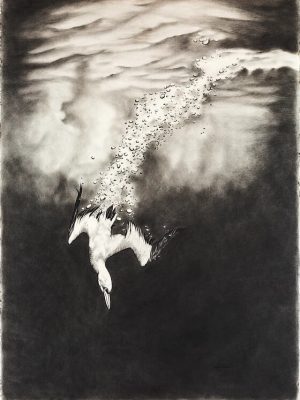
This Limited Edition Print is 60 cm x 80 cm
The Australasian gannet (Morus serrator), also known as Australian gannet and tākapu, is a large seabird of the booby and gannet family, Sulidae. Adults are mostly white, with black flight feathers at the wingtips and lining the trailing edge of the wing. These amazing birds dive from heights of 30 metres, entering the water at speeds of up to 100 km/h.
This is an Archival Print.
Price includes postage within Australia

Cape Raoul, southern Tasmania
Watercolour and gouache on 640 gsm hot press Lana rag paper - H120 cms x W 150 cms. Framed
The Short-tailed Shearwater (Ardenna tenuirostris) is Australia’s most numerous seabird. During breeding season, millions converge on many small islands around southern Australia, with their stronghold in Bass Strait. Cape Raoul is at the southernmost tip of the Tasman Peninsula in Tasmania. The cape features rock platforms, towering 300 metre cliffs, columns and off-shore islands.
This original piece is SOLD
Please get in contact for more information.
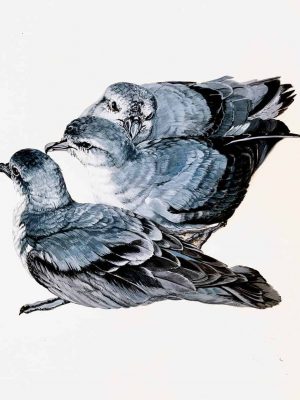
Print Size: 25cm x 25cm (with matt surround)
The Southern fairy prion is a member of the Pachyptila genus, and along with the blue petrel makes up the prions. They in turn are members of the Procellariidae family, and the Procellariiformes order. The prions are small and typically eat just zooplankton;[2] however as a member of the Procellariiformes, they share certain identifying features. First, they have nasal passages that attach to the upper bill called naricorns. Although the nostrils on the albatross are on the sides of the bill. The bills of Procellariiformes are also unique in that they are split into between 7 and 9 horny plates. They produce a stomach oil made up of wax esters and triglycerides that is stored in the proventriculus. This is used against predators as well as an energy rich food source for chicks and for the adults during their long flights.[3] Finally, they also have a salt gland that is situated above the nasal passage and helps desalinate their bodies, due to the high amount of ocean water that they imbibe. It excretes a high saline solution from their nose.
This is an archival print.
*Price includes postage anywhere within Australia.
